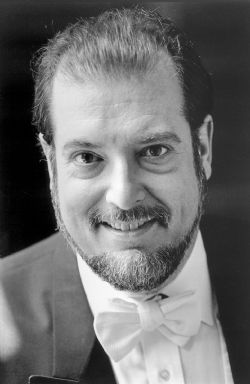|
Symphony
SRS SEASON ENDS WITH RESOUNDING TA-TA-TA-BANG
by Terry McNeill
Sunday, June 1, 2025
Symphony
YOUTHFUL VIRTUOSITY ON DISPLAY AT USO'S MAY CONCERTS
by Peter Lert
Saturday, May 17, 2025
Symphony
MYSTICAL PLANETS AND LIVELY GERSHWIN ORTIZ AT FINAL SRS CONCERT
by Peter Lert
Sunday, May 4, 2025
Symphony
VSO'S CONCERT MUSIC OF TIME, MUSIC OF PLACE
by Peter Lert
Sunday, April 27, 2025
Choral and Vocal
VOCAL ELEGANCE AND FIRE AT THE 222'S RECITAL APRIL 26
by Pamela Hicks Gailey
Saturday, April 26, 2025
CANTIAMO SONOMA SINGS AN INSPIRED GOOD FRIDAY MOZART REQUIEM CONCERT
by Pamela Hicks Gailey
Friday, April 18, 2025
DRAMATIC SHOSTAKOVICH SYMPHONY CLOSES PHILHARMONIC'S 25TH SEASON
by Terry McNeill
Sunday, April 13, 2025
LARGE COLLEGE OF MARIN AUDIENCE GREETS STOPHER ARTISTRY
by Terry McNeill
Saturday, April 5, 2025
Chamber
FRISSON DELIVERS SHIVERS OF DELIGHT
by Abby Wasserman
Sunday, March 30, 2025
OLD AND MOSTLY NEW IN SRS MARCH CONCERT IN WEILL
by Peter Lert
Saturday, March 22, 2025
|
 |
 Garrick Ohlsson, guest soloist, piano |
SHIFTING THE CENTER OF ATTENTION
by Steve Osborn
Saturday, February 21, 2009
Symphony programs often resemble three-ring circuses, organized in time rather than space. In the first ring, the symphony offers an overture or similar fare to whet your aural appetite. Then, in the center ring, comes the main attraction, usually a soloist displaying his chops in a concerto or other showpiece. The final ring is reserved for a symphony or other lengthy work that exhibits the orchestra in its full glory.
The Santa Rosa Symphony’s program on Feb. 21 at the Wells Fargo Center hewed to the familiar scheme, except that the soloist, Bay Area pianist Garrick Ohlsson, played on both sides of intermission, first in Carl Maria von Weber’s Konzertstück, then in Manuel de Falla’s Noches en los jardines de España (Nights in the gardens of Spain). The former displayed Ohlsson’s staggering technical prowess to full effect, the latter offering more opportunities for musicality.
On this program, though, the outer rings eclipsed the ostensible star attraction. This was less a function of the performances than of the music at hand: Arnold Schoenberg’s Verklärte Nacht (Transfigured night) at one end of the program, Debussy’s Nocturnes at the other. When all was played and done, Schoenberg and Debussy put Weber and Falla in the shade.
Not that there’s anything much wrong with either of the concertante works, at least in the hands of Garrick Ohlsson. In the Weber he was commanding from the beginning, playing the opening phrase with as much space between the notes as forward momentum would allow. Every note was discrete, every tone fully resonant. Then came the full attack, marked by intense crescendos and accelerandos and devastating trills.
Throughout all his digital fireworks, Ohlsson sat imperturbable on the piano stool, his upper body planted like a tree trunk as his hands raced across the keyboard. He stared straight forward, occasionally looking down at the keys to make sure his fingers were still attached. He played impossibly fast, often interweaving his hands to dramatic effect. When he was done, the audience erupted in sustained applause.
It was thrilling playing, but the Konzertstück itself is little more than a standard-issue showpiece, patching together one motive after another to display the soloist’s prestidigitations. The rarely performed Falla promised a little more musical meat.
The first “night,” “En el Generalife” (In the Generalife), was somewhat skeletal, with lots of French Impressionist tremolos from the strings and many hand crossings from Ohlsson. Flesh began appearing on the bones in the second “night,” “Danza lejana” (Distant dance). The music turned more Spanish, with Music Director Bruno Ferrandis provoking some fiery tempos from the orchestra and Ohlsson matching them stride for stride. Sadly, the third “night,” “En los jardines de la Sierra de Córdoba” (In the gardens of the Sierra de Córdoba) with its hints of flamenco, didn’t seem to gel, either in composition or in performance.
The uncertain air of the Falla stood in contrast to the confident personalities of Schoenberg, whose Verklärte Nacht began the program, and Debussy, whose Nocturnes brought it to a magical close. The two pieces, both completed in 1899, are similar not only in their nocturnal subjects, but also in their emotional intensity and musical innovation.
Verklärte Nacht, originally for string sextet, was performed in the composer’s string-orchestra version, which adds basses, splits the various string sections, and frequently alternates between first-chair solos and full ensemble. The additional players make the work even lusher and more romantic than its erotically charged original, but often at the expense of clarity. Although Ferrandis pushed the rhythms and brought out some of the main themes, the orchestra was occasionally muddy. Nonetheless, the performance was heartfelt and emotional, nowhere more so than in a passage near the end where different players began arpeggiating over open strings. The effect of this clear sound after so much dense and often muted texture was liberating, even joyful.
Those same emotions were also at play in the Debussy Nocturnes. From the haunting opening for English horn, beautifully played by one of the symphony’s many unidentified freelancers, the piece transports its listeners to another world. Ferrandis exerted such control over the dynamics in this opening movement, “Nuages” (Clouds), that the entire auditorium was at times enveloped in silence.
The silence found its counterpart in the second nocturne, “Fêtes” (Festivals), which Ferrandis moved along briskly, with precise motions and fastidious attention to orchestral detail. The third and final Nocturne, “Sirènes” (Sirens), featured female voices from the symphony’s choir, blending seamlessly with the orchestra to evoke Debussy’s vision of temptation and longing.
The program ended as it had begun, on the outer rings. Somehow the center of attention had drifted to the edges.
[This article first appeared in San Francisco Classical Voice (www.sfcv.org), and is used by permission.]
|
